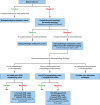Laboratory Diagnosis of Infective Endocarditis
- PMID: 28659319
- PMCID: PMC5648697
- DOI: 10.1128/JCM.00635-17
Laboratory Diagnosis of Infective Endocarditis
Abstract
Infective endocarditis is life-threatening; identification of the underlying etiology informs optimized individual patient management. Changing epidemiology, advances in blood culture techniques, and new diagnostics guide the application of laboratory testing for diagnosis of endocarditis. Blood cultures remain the standard test for microbial diagnosis, with directed serological testing (i.e., Q fever serology, Bartonella serology) in culture-negative cases. Histopathology and molecular diagnostics (e.g., 16S rRNA gene PCR/sequencing, Tropheryma whipplei PCR) may be applied to resected valves to aid in diagnosis. Herein, we summarize recent knowledge in this area and propose a microbiologic and pathological algorithm for endocarditis diagnosis.
Keywords: clinical microbiology; endocarditis.
Copyright © 2017 American Society for Microbiology.
Figures


References
-
- Baddour LM, Wilson WR, Bayer AS, Fowler VG Jr, Tleyjeh IM, Rybak MJ, Barsic B, Lockhart PB, Gewitz MH, Levison ME, Bolger AF, Steckelberg JM, Baltimore RS, Fink AM, O'Gara P, Taubert KA. 2015. Infective endocarditis in adults: diagnosis, antimicrobial therapy, and management of complications: a scientific statement for healthcare professionals from the American Heart Association. Circulation 132:1435–1486. doi: 10.1161/CIR.0000000000000296. - DOI - PubMed
-
- Murdoch DR, Corey GR, Hoen B, Miro JM, Fowler VG Jr, Bayer AS, Karchmer AW, Olaison L, Pappas PA, Moreillon P, Chambers ST, Chu VH, Falco V, Holland DJ, Jones P, Klein JL, Raymond NJ, Read KM, Tripodi MF, Utili R, Wang A, Woods CW, Cabell CH. 2009. Clinical presentation, etiology, and outcome of infective endocarditis in the 21st century: the International Collaboration on Endocarditis-Prospective Cohort study. Arch Intern Med 169:463–473. doi: 10.1001/archinternmed.2008.603. - DOI - PMC - PubMed
-
- Raoult D, Casalta JP, Richet H, Khan M, Bernit E, Rovery C, Branger S, Gouriet F, Imbert G, Bothello E, Collart F, Habib G. 2005. Contribution of systematic serological testing in diagnosis of infective endocarditis. J Clin Microbiol 43:5238–5242. doi: 10.1128/JCM.43.10.5238-5242.2005. - DOI - PMC - PubMed
Publication types
MeSH terms
Substances
LinkOut - more resources
Full Text Sources
Other Literature Sources

